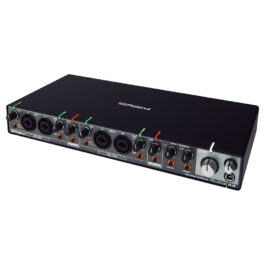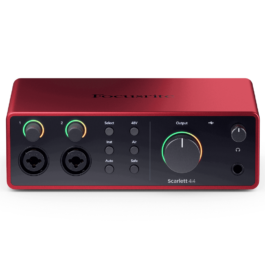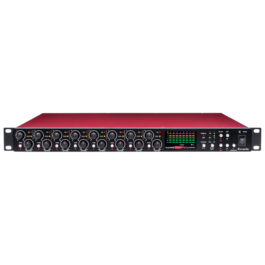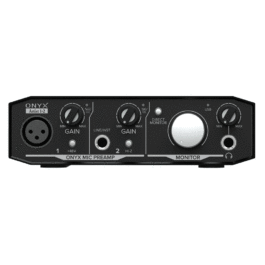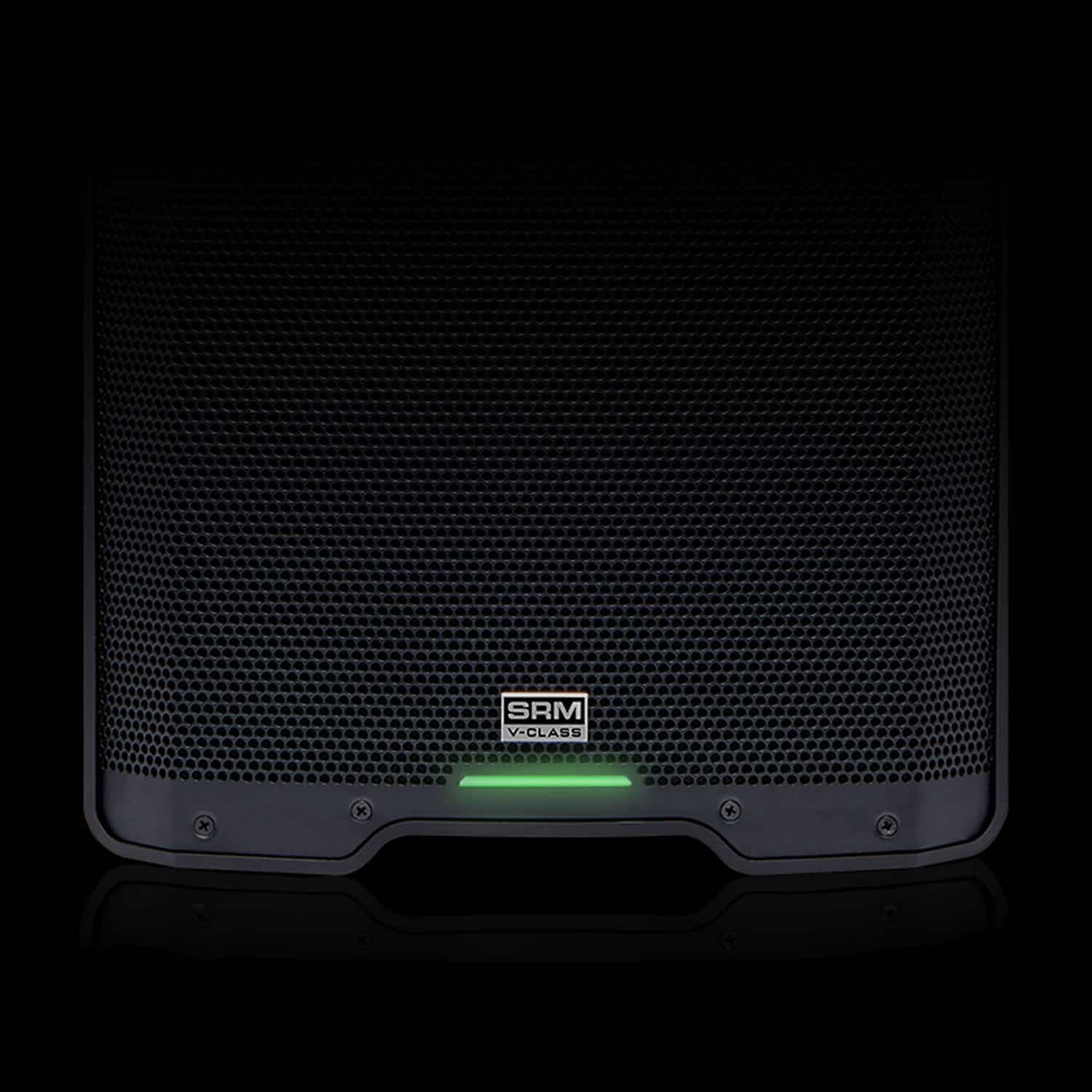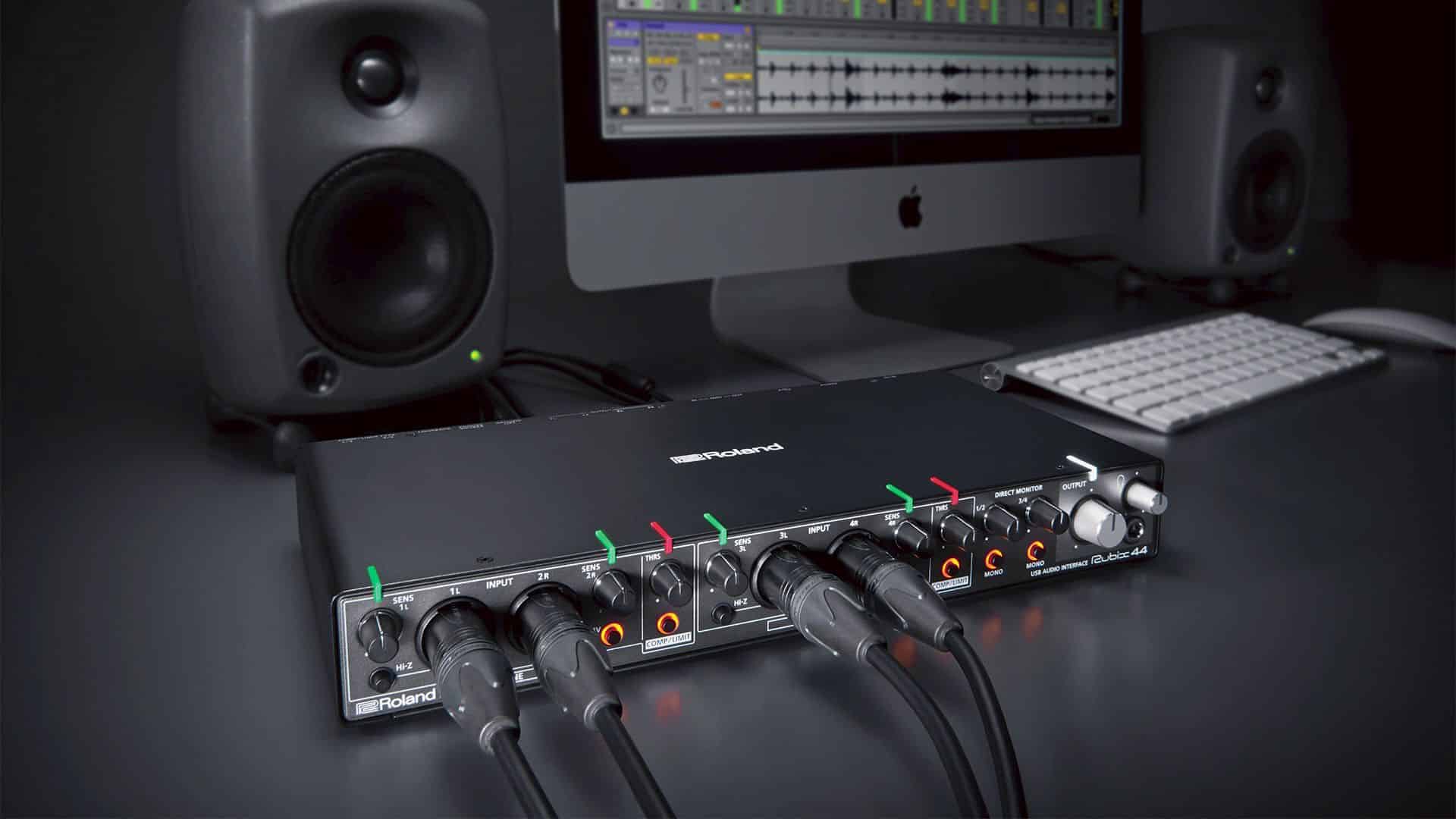
The landscape of desktop audio interfaces is incredibly vast, with strong competition between a number of manufacturers. Focusrite, Mackie, Behringer, Presonus, and more all compete with one another based on three primary factors – number of channels, feature set, and price.
This is especially relevant in the realm of one and two channel audio interfaces, as is the common option for most beginners.
But what if you’re looking to do a little more? With more channels, a great feature set, and a competitive price, we think the Roland Rubix44 is a stand-out option.
Let’s take a look at what makes it tick.
The Channels


The most obvious feature that sets the Rubix44 apart from competition in this price point is the fact that it includes 4 Combo jack input channels, as well as 4 line level output channels.
To sweeten the deal they’ve powered these 4 channels with Roland high-quality pre-amps carefully designed for pristine sound and low-noise performance.
And perhaps even more critically, Roland have put particular emphasis on high quality AD/DA conversion, allowing warm and clear high-resolution audio up to 24-bit/192 kHz, which is practically unheard of at this price point.
The Features

In true Roland fashion, this unit has been designed with the user in mind.
As mentioned all the inputs include XLR combo jacks, alongside this the Hi-Z inputs let you connect a variety of sources including mics and guitars, with no need for adapters or special cables. Four individual outputs enable sophisticated routing and monitoring possibilities, like sending a click to a performer, setting up a stage monitor, or routing audio to external gear.
Dynamic sources like percussion instruments often need level taming with dynamics processing. The Rubix44 is equipped with compressor/limiters on inputs 1/2 and 3/4, ensuring clear, hot signals without clipping and unwanted distortion. The dynamics processing is completely analog, providing smooth and transparent control with zero added latency.
Monitoring is one of the most fundamentally important factors in a recording environment, and the Rubix44 addresses just that. It features quick-access knobs for adjusting the overall volume and headphones level, plus dedicated Direct Monitor controls for latency-free monitoring without having to fuss with a computer-based mixer.
- 4-in/4-out USB audio interface
- 4 low-noise mic preamps with XLR combo jacks
- Hardware compressor/limiter
- Hi-Z input for guitar and other high impedance sources
- MIDI In/Out ports
- Extensively shielded, low-noise design
- Sturdy and compact metal construction
- Big, easy-to-read indicators show vital information
- Low latency, class compliant drivers
- Ground lifts for quiet operation in a variety of venues
- Includes six months of Roland Cloud Pro membership
- System
- Number of Audio Record/Playback Channels
- Record: 4 channels
Playback: 4 channels - Signal Processing
- PC interface: 24 bits
AD/DA conversion: 24 bits - Sampling Frequency
- AD/DA conversion: 44.1 kHz, 48 kHz, 96 kHz, 192 kHz
- Interface
- Hi-Speed USB
MIDI IN, OUT - Connectors
- INPUT (1L, 2R, 3L, 4R) connectors: XLR type (balanced, phantom power: +48 V, 6 mA Max *1)
INPUT (1L, 2R, 3L, 4R) jacks *2: 1/4-inch TRS phone type (balanced)
PHONES jack: Stereo 1/4-inch phone type
OUTPUT (1L, 2R, 3L, 4R) jacks: 1/4-inch TRS phone type (impedance balanced)
MIDI (IN, OUT) connectors
USB port: USB Type B
DC IN jack
*1 Current value per channel.
*2 INPUT 1L, 3L support high impedance - Controllers
- SENS 1L, 2R, 3L, 4R knobs
Hi-Z switches
48V switches
THRS knobs
COMP/LIMIT switches
DIRECT MONITOR 1/2 knob
DIRECT MONITOR 3/4 knob
MONO switches
OUTPUT knob
PHONES knob
POWER switch
GROUND LIFT switch
PHONES SOURCE switch
LOOPBACK switch
COMP/LIMIT TYPE 1/2 switch
COMP/LIMIT TYPE 3/4 switch - Indicator
- Level indicators (1L, 2R, 3L, 4R)
Level indicator (COMP/LIMIT)
POWER indicator
Hi-Z indicators
48V indicators
COMP/LIMIT indicators - Characteristics
- Nominal Input Level
- INPUT (1L, 2R, 3L, 4R) connectors (XLR type): -60– -12 dBu
INPUT (1L, 2R, 3L, 4R) jacks (1/4-inch TRS phone type): -44–+4 dBu - Maximum Input Level
- INPUT (1L, 2R, 3L, 4R) connectors (XLR type): +2 dBu
INPUT (1L, 2R, 3L, 4R) jacks (1/4-inch TRS phone type): +18 dBu - Nominal Output Level
- OUTPUT (1L, 2R, 3L, 4R) jacks: -6 dBu (impedance balanced)
- Maximum Output Level
- OUTPUT (1L, 2R, 3L, 4R) jacks: +8 dBu (impedance balanced)
- PHONES Maximum Output Power
- 20 mW + 20 mW (L + R, 47 ohms load)
- Headroom
- 14 dB
- Input Impedance
- INPUT (1L, 2R, 3L, 4R) connectors (XLR type): 4 k ohms or greater (balanced)
INPUT (1L, 2R, 3L, 4R) jacks (1/4-inch TRS phone type): 15 k ohms or greater (balanced)
INPUT (1L, 3L) jacks (1/4-inch phone type): 500 k ohms or greater
*3 When the Hi-Z is turned on - Output Impedance
- OUTPUT (1L, 2R, 3L, 4R) jacks: 2 k ohms (balanced)
PHONES jack: 47 ohms - Residual Noise Level
- INPUT (1L, 2R) –> OUTPUT (1L, 2R): -94 dBu typ. (SENS 1L, SENS 2R knobs: min., input terminated with 600 ohms, IHF-A, typ.)
- Dynamic Range
- AD block INPUT (1L, 2R, 3L, 4R) jacks: 104 dB typ. (SENS 1L, SENS 2R knobs: min.)
DA block OUTPUT (1L, 2R, 3L, 4R) jacks: 109 dB typ. - Other
- Power Supply
- AC adaptor
- Operating System
- Microsoft(R) Windows(R) 7, Windows(R) 8, Windows(R) 8.1, Windows(R) 10
Apple Mac OS X 10.10 or later
Apple iOS 9 or later
* Although Roland has tested numerous configurations, and has determined that on average, a computer system similar to that described above will permit normal operation of the Rubix, Roland cannot guarantee that a given computer can be used satisfactorily with the Rubix based solely on the fact that it meets the above requirements. This is because there are too many other variables that may influence the processing environment, including differences in motherboard design and the particular combination of other devices involved. - Dimensions
- 310 (W) x 165 (D) x 46 (H) mm
12-1/4 (W) x 6-1/2 (D) x 1-13/16 (H) inches - Weight (main unit only)
- 1.8 kg
4 lbs - Accessories
- Setup Guide
Leaflet “USING THE UNIT SAFELY”
Power cord
USB cable
* 0 dBu = 0.775 Vrms
The Price
-
- Studio & Recording, Audio Interfaces, Content Creation, Audio Interfaces
Roland Rubix44 USB Audio Interface
-
R9,495R6,645FREE DELIVERY - Select options
Browse more audio interfaces today...
-
Request Stock
- Out of Stock
- Audio Interfaces, Studio & Recording
Focusrite Scarlett OctoPre Dynamic Mic Preamp
-
R15,995R13,495FREE DELIVERY - Select options
-
-
- Audio Interfaces, Audio Interfaces, Content Creation, Studio & Recording
Rode AI-1 Audio Interface
-
R3,895R3,115FREE DELIVERY - Select options
-
- Studio & Recording, Audio Interfaces, Content Creation, Audio Interfaces
Behringer U-Phoria UM2 Audio Interface
-
R2,150R1,548FREE DELIVERY - Select options
-
- Studio & Recording, Audio Interfaces, Content Creation, Audio Interfaces, Clearance Sale
Mackie Onyx Artist USB Audio Interface
-
R3,195R1,960FREE DELIVERY - Select options
-
- Audio Interfaces, Audio Interfaces, Clearance Sale, Content Creation, Studio & Recording
Mackie Onyx Producer Audio Interface
-
R4,395R2,540FREE DELIVERY - Select options
-
NEW!
- Studio & Recording, Audio Interfaces
Focusrite Scarlett 2i2 4th Gen USB Audio Interface
-
R5,350R4,349FREE DELIVERY - Select options
-
NEW!
- Audio Interfaces, Studio & Recording
Focusrite Scarlett Solo 4th Gen USB Audio Interface
-
R3,795R3,085FREE DELIVERY - Select options


